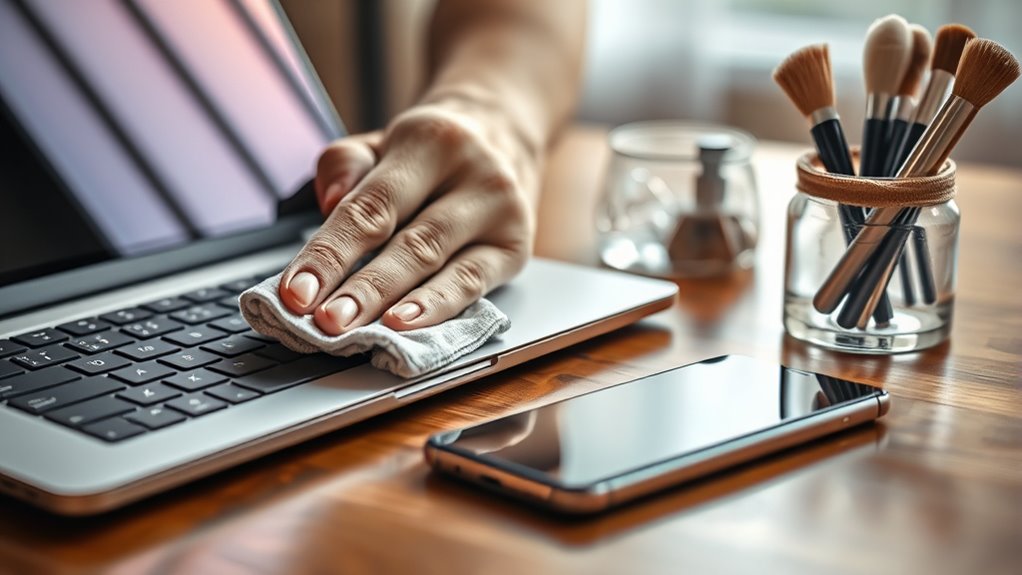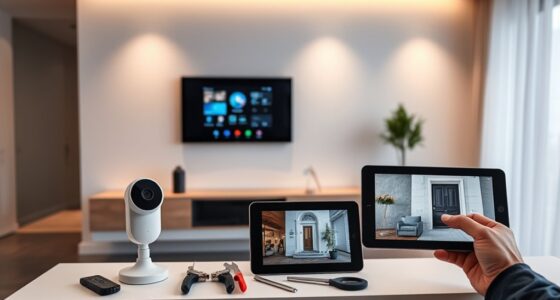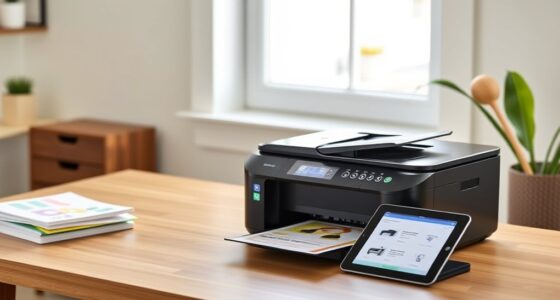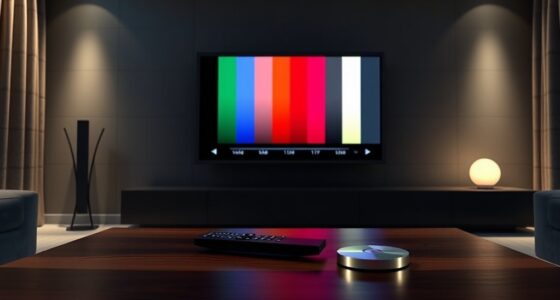To keep your gadgets clean and functioning well, use microfiber cloths dampened with distilled water to wipe screens and surfaces gently. For stubborn smudges, apply diluted isopropyl alcohol with a cotton swab or soft brush to ports and tight spaces. Avoid spraying water directly onto devices, and never submerge them. Regular cleaning prevents dust buildup and damage, helping your gadgets last longer. Keep exploring for more tips to maintain your tech in top shape.
Key Takeaways
- Power off devices before cleaning and use a microfiber cloth dampened with distilled water for screens and surfaces.
- Use compressed air and cotton swabs dipped in diluted isopropyl alcohol to clean ports, keyboards, and tight spaces.
- Avoid spraying or pouring water directly onto gadgets to prevent internal damage and mineral deposits.
- Regularly wipe vents, ports, and exterior surfaces to prevent dust buildup and overheating.
- Protect gadgets with screen protectors and cases, and perform deep cleaning cautiously when disassembling devices.
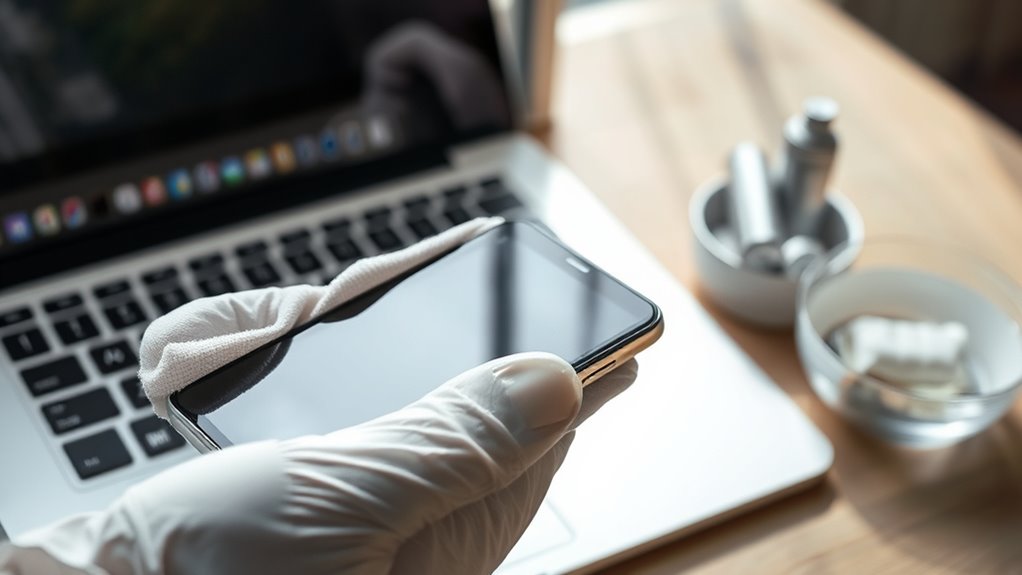
Keeping your tech gadgets clean and well-maintained is essential for their longevity and ideal performance. When you take the time to care for your devices, you not only extend their lifespan but also ensure they operate smoothly. The first step is choosing the right cleaning tools. Microfiber cloths are your best friend—they’re gentle on screens and exterior surfaces, preventing scratches while removing fingerprints and smudges. Always dampen the cloth lightly with distilled water, as tap water can leave mineral deposits that may harm your device over time. Avoid spraying water directly onto screens or ports; instead, gently wipe surfaces. For cleaning ports, cotton swabs dipped in diluted isopropyl alcohol work wonders. They help remove dirt and disinfect without risking liquid damage.
Regularly clean gadgets with a damp microfiber cloth and alcohol-dipped swabs to keep them pristine and functioning smoothly.
When it comes to smartphones and tablets, always power down your device before starting cleaning. This prevents accidental damage from static or moisture. Use a microfiber cloth lightly dampened with distilled water to clean the screens, and for stubborn smudges, a bit of diluted isopropyl alcohol can be applied. Ports like charging jacks and headphone sockets get dirty over time, so carefully insert cotton swabs with alcohol into these areas to dislodge debris. Remember, never pour or spray water directly into these openings. For the device’s back and sides, a quick wipe with a damp microfiber cloth keeps them looking new and disinfected.
Regularly inspecting and maintaining your gadgets helps prevent dust buildup, which can impact their performance.
Laptops require similar care. Always turn off your laptop and unplug it before cleaning. Use a microfiber cloth with distilled water to wipe the screen gently. For the keyboard, a soft-bristled brush helps remove dust and crumbs, while cotton swabs with alcohol clean stubborn dirt in tight spaces. The trackpad can be wiped with a lightly damp microfiber cloth to keep it responsive. The exterior, including vents and ports, benefits from regular wiping with a microfiber cloth dampened with distilled water. This prevents dust buildup, which can cause overheating and performance issues.
Cleaning your keyboard and mouse is straightforward but important. Use compressed air to remove loose dust and debris from between keys. Cotton swabs or a soft brush help dislodge stubborn grime. For the mouse’s surface, a microfiber cloth dampened with distilled water suffices. Never submerge these peripherals in water or use abrasive cloths that could scratch surfaces. Dry cleaning methods are safest to avoid liquid damage.
Regular maintenance helps keep your devices in top shape. Dust and dirt buildup can cause performance issues, so clean your gadgets frequently. Using screen protectors and port covers adds extra protection from scratches and dust. Keeping devices in cases shields them from physical damage and dirt. Remember to update your software regularly to improve security and performance. For deep cleaning, advanced users might disassemble devices to clean internal parts with appropriate tools, compressed air, and cautious use of isopropyl alcohol. Always reassemble carefully to ensure everything functions correctly. Prioritize safety by avoiding excessive moisture, rough materials, and direct sunlight to keep your gadgets in excellent condition.
Frequently Asked Questions
Can I Use Household Cleaning Products on My Gadgets?
You might think household cleaning products are safe for your gadgets, but they often contain harsh chemicals like ammonia or bleach that can damage screens and coatings. Spraying directly onto devices risks internal damage, and abrasive cleaners can scratch delicate surfaces. It’s best to avoid these products and use a soft, damp microfiber cloth with approved electronics cleaners. This way, you protect your gadgets and keep them in good condition longer.
How Often Should I Clean My Tech Devices?
Did you know that your smartphone can carry up to 10 times more germs than a toilet seat? You should clean your devices frequently—personal gadgets like smartphones need daily or multiple times weekly cleaning, especially if shared or in high-use areas. Computer screens and monitors can be cleaned twice a week, while internal parts need dusting every 4-6 months. Regular cleaning keeps your tech safe, efficient, and germ-free.
Is It Safe to Clean Screens With Alcohol?
You wonder if it’s safe to clean screens with alcohol. While 70% isopropyl alcohol can disinfect, it might damage certain coatings like anti-glare or protective layers. To stay safe, avoid applying alcohol directly—use a damp microfiber cloth instead. Check your screen’s compatibility first. If unsure, opt for water or specialized screen cleaners. This way, you clean effectively without risking damage to your device.
What Tools Are Best for Cleaning Tiny Ports?
Think of tiny ports as delicate corridors that need gentle cleaning. You’ll want tools like precision cleaning kits, cotton swabs, and dental picks to reach those tight spots without causing harm. Use microfiber cloths for exterior surfaces and contact cleaner for stubborn debris. For best results, apply minimal moisture, work slowly, and always dry thoroughly. These tools act as your vigilant guardians, keeping your ports clean and functioning smoothly.
How Do I Prevent Static Damage During Cleaning?
To prevent static damage during cleaning, you need to control static buildup and discharge. Use anti-static mats, wristbands, and ESD-safe wipes to dissipate static safely. Keep electronics away from synthetic materials and avoid using compressed air near fans or HVAC systems. Ground yourself with wrist straps, handle components by edges, and store devices in anti-static bags. Regularly inspect grounding systems and keep your workspace clean and dust-free for ideal static control.
Conclusion
Now that you know how to keep your gadgets sparkling and running smoothly, go ahead—imagine your phone’s screen gleaming like a tiny mirror, undisturbed by fingerprints or dust bunnies. With just a little effort, your devices won’t turn into digital relics or sneeze-inducing germ farms. So, grab that microfiber cloth, channel your inner tech wizard, and give your gadgets the spa treatment they deserve—because even your devices crave a little pampering.

